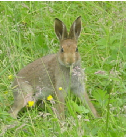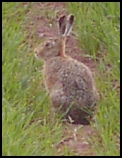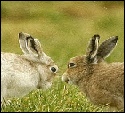
The fur colour of Irish hares varies greatly and individuals can range from a light brown colour to darker russet red. It’s fur rarely turns wholly white in winter, although it may vary in colour throughout the year, sometimes developing white patches. On rare occasions all-




Due to the variation in colour, Irish hares may be confused with brown hares. Brown, or European, hares (Lepus euroeaus) were originally introduced to Ireland in the 19th century but are thought to have died out. European hares recorded more recently in north-
Brown hares have longer ears and a mottled (thrush) coat. Some texts cite using the black upper tails of brown hares to distinguish them from Irish hares. However, some Irish hares may also have black upper tails and this trait should not be relied on for identification.


The famous ‘golden hare’, found on Rathlin Island on the north coast of Ireland is a rare leucistic mutation with a yellow tinted coat and blue eyes.
The Irish hare (Lepus timidus hibernicus) is the only hare native to Ireland and is arguably our oldest surviving Irish mammal. It is genetically different to the mountain or blue hare, which is native to Scotland. The Irish hare is now known to have been present in Ireland since before the last ice age and there is a compelling argument to support its classification as a species in its own right. Irish hares have also been recorded on Mull, where they were introduced over 100 years ago.
Irish hares appear to be relatively solitary animals for most of the year with a limited range. Studies have produced figures of between 10Ha and 40Ha as the Irish hare’s typical range. Although not highly social, Irish hares exist as local populations, some of which have now become extinct. The systematic depletion and disappearance of these local populations constitute a threat to the whole species.
The phenomena of ‘boxing’ hares and hare ‘circles’ are associated with mating rituals. Unreceptive females ‘box’ with over-
Irish hares breed throughout most of the year, with leverets recorded from January through to November. With a gestation period of 52 days and a lactation of around 6 weeks, this means that females may be in an active breeding phase at any time. 16 leverets born to captive hares in the month of October suggests that year-
Leverets are born fully furred, with their eyes open. The mother hides them in long grass or vegetation and only returns each night to feed them. During the day they remain absolutely still and rely on cover and camouflage to evade predation. Even when exposed they are not likely to move, which leads people to believe they are injured or orphaned.
It is not unusual to find a leveret on its own and it should never be removed from the wild unless it is in imminent danger. Anyone concerned about the welfare of a leveret should seek advice first. Weaned at around six weeks, the youngster will be left to fend for itself.
While brown hares and mountain hares are found in lowland and highland areas of Great Britain respectively, Irish hares can be found in most habitats from mountains to coastal grassland. However, they are more likely to be found in ‘unimproved’ areas of species rich vegetation. This provides not only food but also cover and shelter where they can lie up during the day. Unlike rabbits, hares do not live in burrows but in a form, a patch of flattened vegetation often with round fibrous droppings (10-
Hares, along with rabbits, are leporids (leporidae). The leporid family, along with pikas, make up the order of lagomorphs (Lagomorpha). Larger than rabbits, adult hares have black tips on the ears and long back legs that give them a distinctive ‘walk’ or lope. The hare is Ireland’s fastest land mammal. The tracks of hares can be distinguished from rabbits’ by their larger size (11-